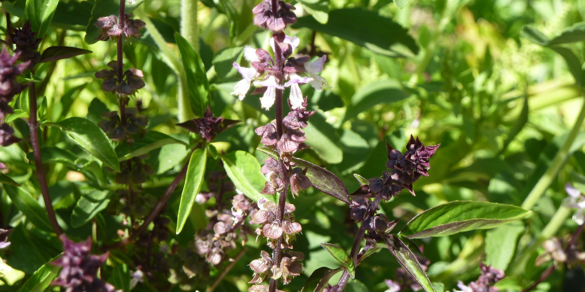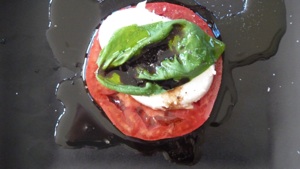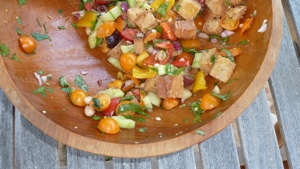
Purple Thai Basil flower spikes in our kitchen garden.
“How can I possibly use an entire bunch of ____________? “
(Fill in the blank with fresh herb of choice)
This is a common query among farmer’s market shoppers and CSA participants. For an herb lover like myself the simple question becomes complicated to answer, since so many possibilities spring to mind. In our kitchen fresh herbs are employed on a daily basis, so we easily consume full bunches without much thought. In addition to our farm bag we’re also blessed with a garden bed filled with aromatic basil, thyme, chives, parsley, oregano and more. Clearly we jumped on the fresh herb bandwagon years ago.
What I’ve learned in talking to people is that not all households are as fluent with garden fresh herbs as ours. I too remember a pre-herbal time in my own life – a childhood kitchen stocked with dried bay leaves and a few other herbal workhorses, but a place where fresh basil and cilantro had no presence. Curly parsley made the occasional appearance, but it was a solo guest relegated to an isolated perch on the edge of the plate, more spectator than participant. For many, fresh herbs feel more like a garnish than a vital component of any dish.
Veteran cooks have long appreciated the ability of green herbs to enhance the taste of particular foods with which they share flavor affinity. These special pairings allow herbs to showcase their partners in an extraordinarily delicious manner. In this way basil naturally elevates tomatoes, as mint does lamb. Minced rosemary offers roasted potatoes perfect pazzaz, while salsa is simply a sauce without cilantro.

Italian Caprese Salad: Tomato, Fresh Mozzarella and Basil. A perfect marriage of flavors -- so simple to compose, yet utterly sophisticated in taste.
For those trying to cut down on salt or meat consumption, herbs may be the perfect answer. Adding a handful of fresh herbs to many dishes offers such robust flavor any deficit in salt or fat is offset. Taste buds are satisfied and culinary bad habits become less tempting. Plus there’s health benefit packed right into these leaves and stems. For instance cilantro is thought to work toward lowering cholesterol, while basil provides protection against disease-causing bacteria making it a wise addition to salads and other raw dishes. Oregano is loaded with antioxidants, gram for gram as powerful as any super food, and research shows parsley has the ability to inhibit tumor growth. Thyme has long been used in natural medicine to promote respiratory health and healing.
Flavor is less concentrated in fresh herbs than dry so you can use them more liberally. If you plan to substitute one for the other you’ll need roughly three times the amount of fresh than dry (depending on the herb). One reason to try fresh herbs is that their dried brethren can easily end up devoid of flavor, sitting on the shelf, as they often do, for extended periods (decades in some cases that I know of). As a general rule of thumb, try to use dried herbs within 6 months or less (store in the freezer for extended life).
Certain fresh herbs, like cilantro and basil may be used in large amounts with sensational results. Last night we threw together an Italian Panzanella (tomato and bread salad) that boasted nearly a full cup of shredded basil leaves. The results were glorious: basil offering the perfect finish of bright, almost clove-like flavor that marries with tomato like no other. Without the fresh green leaves this salad would have been simply ordinary rather than the flavor-packed dish we quite literally devoured.

Often the flavor and aroma of herbs conjures up the feeling of a particular place or cuisine – cilantro may remind us of Mexico or the Middle East; basil offers a taste of Italy; mint transports us to Vietnam. Simply chop up a handful and toss into your dish to provide quick and easy ethnic authenticity.
Herbs have varying tolerances and affinities for heat – some benefit from extended cooking while others lose their potency with even the smallest amount. Cilantro and basil should be added after food is cooked, just be serving, while thyme, rosemary and oregano enjoy dallying in pots throughout the cooking process. Parsley, flexible herb that it is, can be cooked into food or used raw with equal success.
Discover the flavor magic of fresh herbs – you’ll no longer wonder what to do with an entire bunch. Instead you’ll find yourself asking for more.
Often the flavor and aroma of herbs conjures up the feeling of a particular place or cuisine – cilantro may remind us of Mexico or the Middle East; basil offers a taste of Italy; mint transports us to Vietnam. Simply chop up a handful and toss into your dish to provide quick and easy ethnic authenticity.
Herbs have varying tolerances and affinities for heat – some benefit from extended cooking while others lose their potency with even the smallest amount. Cilantro and basil should be added after food is cooked, just be serving, while thyme, rosemary and oregano enjoy dallying in pots throughout the cooking process. Parsley, flexible herb that it is, can be cooked into food or used raw with equal success.
Discover the flavor magic of fresh herbs – you’ll no longer wonder what to do with an entire bunch. Instead you’ll find yourself asking for more.
Recipe – Moroccan Carrot Salad
Recipe – Italian Bread Salad (Panzanella)

